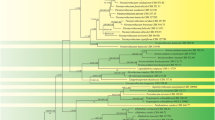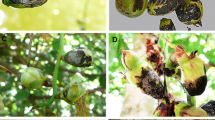Abstract
Plasmopara invertifolia sp. nov. causes severe leaf distortion and necrosis on Helichrysum bracteatum, a beautiful and important ornamental plant for trade in Brazil. This oomycete pathogen is distinguished from other species of Plasmopara on Asteraceae by its smaller sporangia and larger sporangiophores, which justifies the proposition of a new taxon in the genus Plasmopara to accommodate it. The phylogenetic analysis of cox2 gene sequence data supports such placement and also shows that P. invertifolia is close to the P. halstedii complex. Plasmopara invertifolia is then described, illustrated and discussed.


Similar content being viewed by others
References
Campbell L (1932) Some species of Plasmopara on composites from Guatemala. Mycologia 24:330–333
Ciferri R (1956) Mycoflora domingensis exsiccata. Sydowia 10(6):130–180
Choi YJ, Kiss L, Vajna L, Shin HD (2009) Characterization of a Plasmopara species on Ambrosia artemisiifolia, and notes on P. halstedii, based on morphology and multiple gene phylogenies. Mycol Res 113:1127–1136
Choi YJ, Shin HD (2008) Reclassification of Bremia domingensis to the genus Plasmopara as P. domingensis comb. nov. Mycotaxon 105:191–194
Choi YJ, Thines M, Runge F, Hong SB, Telle S, Shin HD (2011) Evidence for high degrees of specialisation, evolutionary diversity, and morphological distinctiveness in the genus Bremia. Fungal Biol 115:102–111
Constantinescu O, Thines M (2010) Plasmopara halstedii is absent from Australia and New Zealand. Pol Bot J55:293–298
Duarte LL, Barreto RW (2009) First report of stem rot of Helichrysum bracteatum by Sclerotinia sclerotiorum in Brazil. Austral Plant Dis Notes 4:100–101
Farr DF, Rossman AY, Palm ME, McCray EB (2013) Fungal databases, systematic botany and mycology laboratory, ARS, USDA. http://nt.ars-grin.gov/fungaldatabases/ Accessed 15 January 2013
Göker M, Voglmayr H, Riethmüller A, Oberwinkler F (2007) How do obligate parasites evolve? A multi-gene phylogenetic analysis of downy mildews. Fungal Genet Biol 44:105–122
Hall G (1989) Plasmopara halstedii. CMI Descriptions of Fungi and Bacteria No 979. Mycopathologia 106:205–207
Hudspeth DSS, Nadler SA, Hudspeth MES (2000) A COX2 molecular phylogeny of the Peronosporomycetes. Mycologia 92:674–684
Ito A (1935) Notae mycologicae asiae orientalis I. Trans Sapporo Nat Hist Soc 14:11–33
Komjáti H, Walcz I, Virányi F, Zipper R, Thines M, Spring O (2007) Characteristics of a Plasmopara angustiterminalis isolate from Xanthium strumarium. Eur J Plant Pathol 119:421–428
Lorenzi H, Souza HM (2001) Plantas ornamentais no Brasil: arbustivas, herbáceas e trepadeiras. Instituto Plantarum, Nova Odessa
Morley B (1978) Helichrysum bracteatum and allies. Garden 103:489–491
Novatelnova NS (1963) Species novae generis Plasmoparae ad Compositas. Bot Mat 16:73–83
Schröder S, Telle S, Nick P, Thines M (2011) Cryptic diversity of Plasmopara viticola (Oomycota, Peronosporaceae) in North America. Org Divers Evol 11(1):3–7
Silvestro D, Michalak I (2012) raxmlGUI: a graphical front-end for RAxML. Org Divers Evol 12(4):335–337
Stamatakis A (2006) RAxML-VI-HPC: maximum likelihood-based phylogenetic analyses with thousands of taxa and mixed models. Bioinformatics 22:2688–2690
Stanghellini ME, Gilbertson RL (1988) Plasmopara lactucae-radicis, a new species on roots of hydroponically grown lettuce. Mycotaxon 21(2):395–400
Sydow H, Sydow P (1939) Fungi aequatoriensis. Ann Mycol 37:275–438
Tamura K, Peterson D, Peterson N, Stecher G, Nei M, Kumar S (2011) MEGA5: molecular evolutionary genetics analysis using maximum likelihood, evolutionary distance, and maximum parsimony methods. Mol Biol Evol 28(10):2731–2739
Tao J (1991) Recognition of the genus Paraperonospora and the species from China. J Yunnan Agric Univ 6:129–135
Tao JF, Qin Y (1987) Taxonomic studies on the genus Plasmopara of China III. New species, new combination and new record Plasmopara on family Compositae. Acta Mycol Sin 6:65–73
Thines M (2011) Recent outbreaks of downy mildew on grape ivy (Parthenocissus tricuspitada, Vitaceae) in Germany are caused by a new species of Plasmopara. Mycol Progress 10:415–422
Thompson JD, Gibson TJ, Plewniak F, Jeanmougin F, Higgins DG (1997) The CLUSTAL_X windows interface: flexible strategies for multiple sequence alignment aided by quality analysis tools. Nucleic Acids Res 25(24):4876–4882
Acknowledgments
Financial support by the Coordenação de Aperfeiçoamento de Pessoal de Nível Superior (CAPES) to who LLD and RWB is gratefully acknowledged. YJC appreciates support by the Alexander-von-Humboldt Foundation.
Author information
Authors and Affiliations
Corresponding author
Rights and permissions
About this article
Cite this article
Duarte, L.L., Choi, YJ., Soares, D.J. et al. Plasmopara invertifolia sp. nov. causing downy mildew on Helichrysum bracteatum (Asteraceae). Mycol Progress 13, 285–289 (2014). https://doi.org/10.1007/s11557-013-0913-7
Received:
Revised:
Accepted:
Published:
Issue Date:
DOI: https://doi.org/10.1007/s11557-013-0913-7




